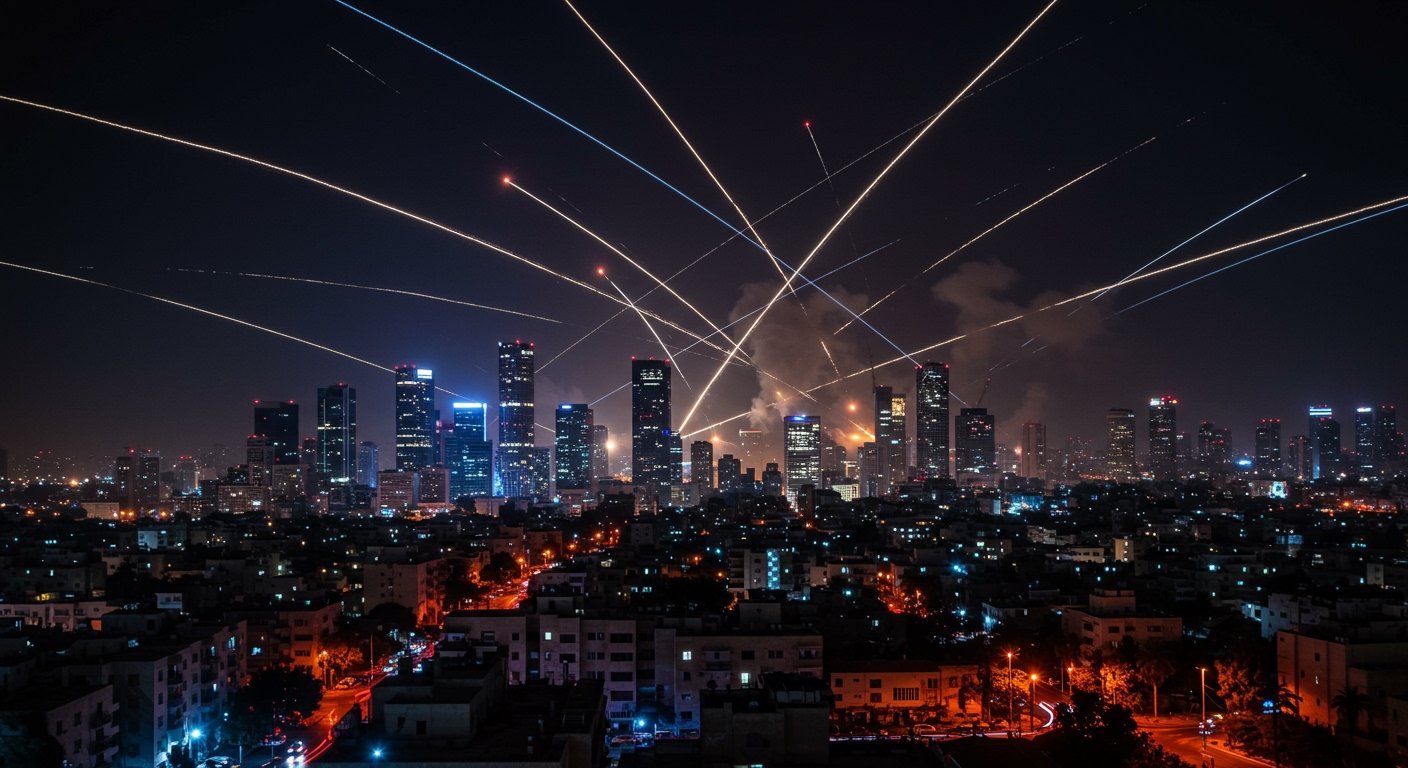On Friday, June 20, 2025, Iran’s Corps of Guardians of the Islamic Revolution (IRGC) launched a significant military operation targeting Israel. This action marked the seventeenth wave of attacks under the designated name “Operation True Promise 3.” The coordinated assault involved the deployment of various aerial munitions, including missiles and drones, according to statements from the Iranian side. Initial reports from the region quickly indicated a widespread impact across Israeli territory and areas of occupied Palestine.
Reports from the Ground
Israeli media outlets provided extensive coverage of the unfolding events, reporting intense missile bombardments impacting multiple areas. Among the locations cited were the major port city of Haifa in the north, the area around the Dead Sea, parts of the southern Negev desert region, and the central metropolis of Tel Aviv. These reports suggested a broad geographical scope for the attacks, targeting key strategic and population centers. Haifa, a major port and industrial hub, is vital to the Israeli economy. Tel Aviv represents the country’s primary economic and cultural center, as well as housing key government and military offices. The Negev desert region includes significant military bases and strategic sites like Dimona, known for its nuclear facility (though the summary only mentions Dimona in the context of sirens, not a confirmed hit). The inclusion of the Dead Sea area suggests a potential targeting of tourism infrastructure or military assets positioned near this unique geographic feature. This broad distribution of reported impacts and alerts indicated an attempt to overwhelm defenses and cause disruption across multiple critical sectors.
The nation was described as being under a state of heightened alert as the barrage commenced. The activation of anti-aircraft sirens was reported continuously across numerous cities and regions. Specifically, sirens blared in Haifa, Al-Quds (Jerusalem), Dimona in the Negev, Beersheba, and Eilat in the far south. Sirens also sounded in several West Bank settlements. These alerts coincided with the sound of loud explosions heard in these same areas, indicating potential impacts or interceptions. The reports painted a picture of a populace under significant stress, prompted by the activation of emergency protocols across wide swaths of the country. The “state of alert” meant residents in the affected zones were advised to seek shelter, a standard procedure during incoming missile or rocket fire. The continuous nature of the siren alerts across a geographically diverse set of cities, from the northern coast (Haifa) to the southern tip (Eilat), and including the capital (Al-Quds/Jerusalem), the southern hub (Beersheba), a sensitive area (Dimona), and settlements in the occupied West Bank, underscored the perceived scale and breadth of the threat detected by Israeli defenses. The accompaniment of these alerts by “loud explosions” in the same areas further heightened the tension, suggesting active engagement between incoming projectiles and defense systems, or potential impacts.
The Israeli army subsequently confirmed that missile launches originating from Iran had indeed occurred, corroborating the nature and source of the aerial assault, though details regarding the number of projectiles or specific impacts were initially sparse in their confirmation as reported in the summary.
Official Iranian Statement
Providing the official perspective from Tehran, Colonel Iman Tayik, who serves as the spokesman for “Operation True Promise 3,” issued a statement detailing the intent and execution of this latest wave. Colonel Tayik asserted that the seventeenth wave of missile and drone attacks was specifically aimed at military installations, military industries, and command and intelligence centers belonging to what he termed the “Israeli regime.”
He further specified the types of armaments deployed in this operation. According to Colonel Tayik, the assault utilized long-range, heavy-weight missiles, alongside offensive and suicide drones. This description suggests the use of weaponry designed for significant reach and payload capacity, aimed at strategic targets as claimed by the Iranian spokesman. The description of the weaponry used, according to Colonel Tayik, pointed to advanced capabilities within Iran’s arsenal. “Long-range, heavy-weight missiles” are designed to strike deep inside enemy territory and carry substantial explosive payloads, capable of causing significant damage to reinforced structures or military complexes. The deployment of “offensive and suicide drones” adds another layer to the attack, allowing for saturation tactics, precision strikes on specific targets, or reconnaissance and targeting coordination, reflecting a hybrid approach utilizing both traditional missile technology and modern unmanned aerial systems.
Colonel Tayik concluded his statement with assertive language regarding the ongoing campaign and future actions. He was quoted as stating, “May the world wait for our surprises…” and added a declaration of confidence in the operation’s ultimate success, saying, “Our sacred defense will triumph with the support of the people.” These remarks positioned the attack as part of a sustained effort and hinted at potential further military actions, underlining the Iranian resolve as presented by the spokesman.
Context of Operation True Promise 3
The designation of this event as the seventeenth wave of “Operation True Promise 3” underscores the nature of the ongoing confrontation as viewed by Iran. Naming military campaigns and numbering their iterations is a strategic communication tactic often used to signal a deliberate, persistent, and planned series of actions rather than isolated incidents. The fact that this marks the seventeenth such wave suggests a sustained operational rhythm since the campaign’s inception, though the summary does not provide details on previous waves or the start date of “Operation True Promise 3” itself, beyond referencing this particular instance on Friday, June 20, 2025. The repeated designation of these attacks as “waves” within “Operation True Promise 3” suggests a sustained, perhaps evolving, military strategy by the IRGC. Each wave, including this seventeenth one on June 20, 2025, is presented by the Iranian side as a deliberate strike with specific objectives. This nomenclature frames the conflict as an ongoing campaign rather than a series of isolated incidents, implying a strategic commitment to continuing these actions.
The targets described by Colonel Tayik – military infrastructure, industrial capacity supporting the military, and command/intelligence nodes – are typically considered high-value strategic objectives in military conflict. The stated goal of targeting such sites with long-range, heavy-weight missiles and various types of drones highlights Iran’s declared intent to degrade Israel’s military capabilities and decision-making apparatus through these aerial assaults.
Conclusion
The events of Friday, June 20, 2025, involving the seventeenth wave of Iran’s “Operation True Promise 3,” represent a significant instance of direct military engagement as described by the involved parties. With Israeli media reporting widespread bombardments affecting areas from Haifa to Tel Aviv, the Dead Sea, and the Negev, coupled with confirmation of missile launches from Iran by the Israeli army, the reality of a major aerial assault was evident on the ground through continuous siren activations and explosions in multiple cities and settlements. The official Iranian statement, delivered by Colonel Iman Tayik, detailed the strategic targets and the types of advanced weaponry allegedly employed, framing the attack as a deliberate strike against Israeli military capacity as part of an ongoing, named operation. The conflicting accounts regarding impacts and the nature of the targets, combined with the declared capabilities of the weapons used and the widespread alerts in Israel, highlight the continued high tensions and direct military exchanges characterizing the relationship between Iran and Israel in this period.





